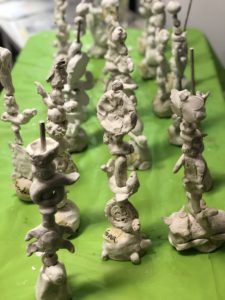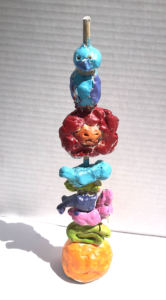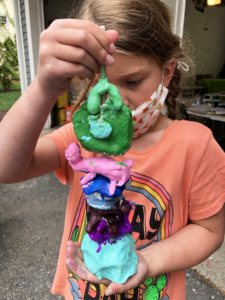
PLANNING
There are six art forms that I strive to introduce my art students within each session of classes: drawing, painting, collage, printmaking, fiber arts, and clay. Clay is from the earth and very different from play dough. Clay work for children has been said to improve hand-eye coordination, and strengthen hand writing skills. To learn more benefit of working with clay you can go here.
Activities using clay can be enjoyed by children of all ages and varying abilities, and typically, it’s a fan favorite in the art room. Some love it more than others, but there is always universal enthusiasm in the art room when this material is brought out. I am not a ceramicist or clay expert of any kind, so maybe the euphoria is because my students know that pretty much anything goes when using clay, except throwing. We have a very strict NO THROWING clay policy in the studio. Otherwise, I say ‘do what you want and have fun’ because it’s a thrilling process art experience.
Materials needed:
2 lbs Air Dry Clay
canvas or plastic mat
plastic cutting tools
small wooden kebab skewer
craft paint
acrylic paint markers (Posca)
acrylic varnish (optional)
4 HOURS + 1 week to dry | Intermediate/Advanced
Ages 9+



To begin the project, we discussed Native American totems and what they symbolize for our Native American/First Nations people. These tall wood carvings are made by approximately 30 different tribes of Native Americans from the Pacific Northwest region of the United States and Canada. They help provide records of Native American lives. Traditionally, there were several kinds of totem poles, such as house/porch columns, grave markers, or welcoming poles. Read more about the different types here and here.
The word totem* refers to an ancestor or guardian that was revered or well respected within the family. A totem is made to read like a vertical story, carved with animals and symbols that represent the family like a crest, and were familiar to all Native Americans within that region. Typical symbols include the form of animals, birds, reptiles and occasionally people. In the end, most of my students ultimately decided to create animals that were their favorites and not necessarily tied to any specific symbolism. We had seals, and whales, and snakes, and birds. I’m pretty sure there were some bunnies in there too.
We used Crayola Air-dry Clay for this project and each student was given a little more than 2 lbs. I provided some silhouetted pictures of animals from the internet as visuals. We reviewed the scratch-and-attach method of adhering clay shapes together, but I gave them no special instructions on how to form specific animals. Quite frankly, the kids didn’t need them.
After they were constructed, we let them dry for almost two full weeks before painting them. We used simple, inexpensive craft paints to paint them. Once the paint was dry, I sprayed them with acrylic varnish to give each totem a shiny finish. These were fun and the finished pieces were impressive.



HOW WE DID IT
For young children, clay exploration is all about experiencing the material because it is cold, sticky and squishable. For the older tween artist, clay is fan favorite, but they are more interested in construction, That’s why I recommend this project for artists in 4th grade or higher. These were the steps we took to make our totems: